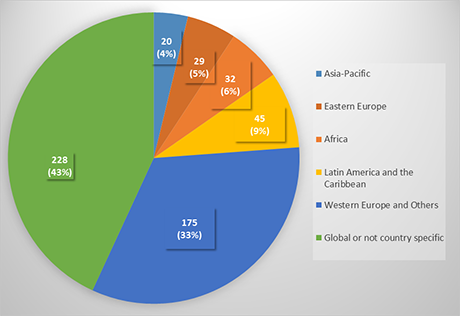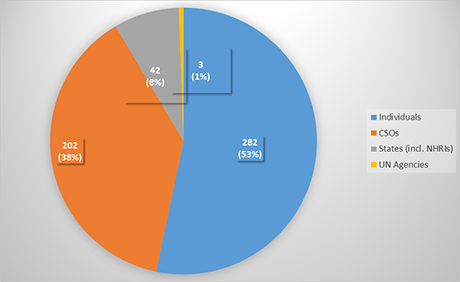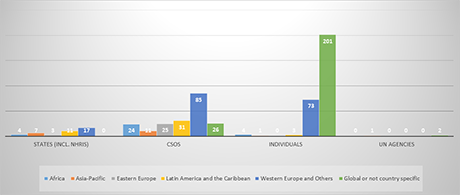Report on Gender Theory
Issued by
Independent Expert on sexual orientation and gender identity
Published
01 June 2021
Issued by
Independent Expert on sexual orientation and gender identity
Published
01 June 2021
Issued by Special Procedures
Subjects
Special Procedures, Sexual orientation and gender identity
Symbol Number
A/HRC/47/27
Summary
The present report is submitted to the Human Rights Council pursuant to Council resolutions 32/2 and 41/18. The Independent Expert on protection against violence and discrimination based on sexual orientation and gender identity, Victor Madrigal-Borloz, analyses the current state of international human rights law in relation to the recognition of gender and gender identity and expression, in connection with the struggle against violence and discrimination in its different forms.
Reader-friendly summary
English:
Issued by Special Procedures
Subjects
Discrimination, Sexual orientation and gender identity
Symbol Number
A/76/152
Summary
The Independent Expert on protection against violence and discrimination based on sexual orientation and gender identity, Victor Madrigal-Borloz, analyses backlash against the incorporation of gender frameworks in international human rights law. The present report complements his report entitled “The law of inclusion” submitted to the Human Rights Council at its forty-seventh session.
Gender theory informed approaches recognize that the meanings attached to sex (and other) differences in relation to social roles, behaviours and expectations are socially created. They also challenge the assumption that gender identity necessarily correlates with biological sex and recognize the validity of a wide range of sexual orientations and gender identities. The recognition of gender as determined by social construct is common to many feminisms, as well as LGBT theory, as is the recognition that gender, sex and sexuality interconnect with other axes of power and identification such as race, age, ethnicity, religion, [dis]ability and health status among others. These approaches provide, for example, recognition of how race is gendered and gender is raced, as well as the many other factors which affect how one is allocated rights, privileges or deficits and limits to rights through social regulation.
Comprehensive and intersectional gender analysis has influenced the interpretation of international human rights law, and many States have adopted gender as a key concept in laws and policies aimed at protecting women and LGBT persons against violence and discrimination. Nevertheless, within multilateral and regional organisations, among other fora, there are currently narratives that, under different lines of characterization (including the accusation of so-called “gender ideology”), seek to eliminate the gender framework from international human rights law instruments and processes, and national legislative and policy documents. These attempts could impact progress achieved over the last four decades on gender equality and the recognition of sexual and gender-based violence and violence and discrimination based on sexual orientation and gender identity.
In addition, there has been a steep rise in the use of platforms by extremist political leaders and religious groups to promote bigotry, dehumanize persons based on their sexual orientation or gender identity, and foster stigma and intolerance among their constituencies. This trend is generated through orchestrated and well-resourced strategies that aim at negatively impacting the progressive recognition of human rights standards relating to gender equality and sexuality. The reports issued by the Independent Expert on protection against violence and discrimination based on sexual orientation and gender identity in 2021 address this issue from two complementary angles.
The first part, “The law of inclusion”, investigates how the concept of gender is enshrined in international human rights law and concludes that gender identity and expression are protected thereunder, and that gender-based approaches and intersectionality provide a sharp lens for analyzing the root causes of violence and discrimination based on sexual orientation and gender identity. They enable the analysis of multiple asymmetries of power, deriving from how sex is understood within society, including those that feed violence and discrimination against women in all their diversity.
The second part, “Practices of exclusion”, analyses backlash against the incorporation of gender frameworks in international human rights law. It concludes that exclusionary narratives and actions related to gender and gender identity exploit preconceptions, stigma and prejudice, creating risks for the rights of all women (including lesbian, bisexual and trans women) and contributing to the perpetuation of violence and discrimination based on sexual orientation and gender identity.
View easy-to-read summary of the report
PDF: English
This research process included a literature review, and a call for inputs, in response to which 529 submissions were received, including a total of 42 submissions from State entities stemming from all regions, and 484 contributions from non-State stakeholders, including 202 from organizations and 282 from individuals. The Independent Expert is humbled by this highly participative process: in total, he received specific information concerning 88 UN Member States, covering all geographic regions and a significant proportion of the populations, cultures, legal traditions and religions of the world.
Submissions are being processes for publication and qualifying submissions will be posted shortly
Number (and percentage) by region

Number (and percentage) by stakeholder type

Number by stakeholder type and by region
